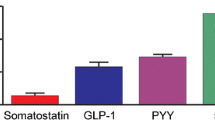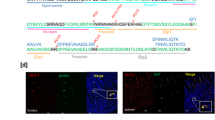Abstract
This study was undertaken to correlate changes in insulin, IGF-1, and IGF-2 receptors in enterocytes both during the phase of active hyperplasia (protocol 1) and the phase of initiation of hyperplasia (protocol 2) induced by 60% proximal jejunoileal resection in rats. Hormone binding to purified receptor preparations, indirect immunofluorescence analysis by flow cytometry, and immunohistochemistry were used to identify receptor changes. Insulin and IGF-2 receptor binding were increased in the intestine two days after surgery and prior to increased cell mass. The number of cells expressing insulin and IGF-1 receptors increased two-and three-fold between 12 and 36 hr after resection, whereas IGF-2 receptors were maintained throughout the 48-hr period. A significant increase in immunoreactive IGF-2 receptors in both the villus and crypt regions of the jejunum and ileum was observed 12 hr after resection, and this increase was maintained in the crypt region of the jejunum through 48 hr. Therefore, insulin and IGF-2 receptors appear to be important in the initiation of cellular hyperplasia following resection.
Similar content being viewed by others
References
Hanson WR, Osborne JW, Sharp JG: Compensation by the residual intestine after intestinal resection in the rat. Gastroenterology 72:692–700, 1977
Morin CL, Ling V, Van Caillie M: Role of oral intake on intestinal adaptation after small bowel resection in growing rats. Pediatr Res 12:268–271, 1978
Albert V, Young GP, Morton CL, Robinson P, Bhathal PS: Systemic factors are trophic in bypassed rat small intestine in the absence of luminal contents. Gut 31:311–316, 1990
Obertop H, Nundy S, Chir M, Malamud D, Malt RA: Onset of cell proliferation in the shortened gut: Rapid hyperplasia after jejunal resection. Gastroenterology 72:267–270, 1977
Milner RDG, Hill DJ: Fetal growth control: The role of insulin and related peptides. Clin Endocrinol 21:415–433, 1984
Fernandez-Moreno MD, Serrano-Rios M, Prieto JC: Identification of insulin receptors in epithelial cells from duodenum, jejunum, ileum, caecum, colon and rectum in the rat. Diabetes Metab 13:135–139, 1987
Forgue-Lafitte ME, Marescot MR, Chamblier MC, Rosselin G: Evidence for the presence of insulin binding sites in isolated rat intestinal epithelial cells. Diabetologia 19:373–378, 1980
Buts JP, De Keyser N, Kolanowski J, Van Hoof F: Hormonal regulation of the rat small intestine: Responsiveness of villus and crypt cells to insulin during the suckling period and unresponsiveness after weaning. Pediatr Res 27:161–164, 1990
Wollen N, Kellett GL: Regulation of glucose homeostasis in rat jejunum by despentapeptide-insulinin vitro. Gut 29:1064–1069, 1988
Heinz-Erian P, Kessler U, Funk B, Gais P, Keiss W: Identification andin situ localization of the insulin-like growth factor-II/mannose-6-phosphate (IGF-II/M6P) receptor in the rat gastrointestinal tract: Comparison with the IGF-I receptor. Endocrinology 129:1769–1778, 1991
Flier JS, Kahn CR, Roth J: Receptors, antireceptor antibodies and mechanisms of insulin resistance. N Engl J Med 8:413–419, 1979
Kahn CR: The molecular mechanism of insulin action. Annu Rev Med 36:429–451, 1985
Kahn CR: Insulin receptors.In: The Diabetes Annual. KGMM Alberti, LP Krall (eds). New York, Elsevier Science Publishers, 1985, pp 446–462
MacDonald RS, Steel-Goodwin L, Smith RJ: Influence of dietary fiber on insulin receptors in rat intestinal mucosa. Ann Nutr Metab 35:328–338, 1991
MacDonald RG, Pfeffer SR, Coussens L, Tepper MA, Brocklebank CM, Mole JE, Anderson JK, Chen E, Czech MP, Ullrich A: A single receptor binds both insulin-like growth factor II and mannose-6-phosphate. Science 239:1134–1137, 1988
SAS Institute, Inc., SASRUser's Guide: Basics, Version 5 Edition. Cary, North Carolina, SAS Institute, Inc., 1985, 1290 pp
Arsenault P, Menard D: Insulin influences the maturation and proliferation of suckling mouse intestinal mucosa in serum-free organ culture. Biol Neonate 46:229–236, 1984
Malo C, Menard D: Synergistic effects of insulin and thyroxine on the differentiation and proliferation of epithelial cells of suckling mouse small intestine. Biol Neonate 44:177–184, 1983
Lee PC, Brooks S, Lebenthal E: Effect of glucose and insulin on small intestinal brush border enzymes in fasted rats. Proc Soc Exp Biol Med 173:372–378, 1983
Fernandez-Moreno M-D, Arilla E, Prieto J-C: Insulin binding to rat intestinal epithelial cells following partial small-bowel resection. BioSci Rep 6:445–450, 1986
Laburthe M, Rouyer-Fessard C, Gammletoft S: Receptors for insulin-like growth factors I and II in rat gastrointestinal epithelium. Am Physiol Soc 254:G457-G462, 1988
Park JHY, Vanderfoof JA, Blackwood D, MacDonald RG: Characterization of type I and type II insulin-like growth factor receptors in an intestinal epithelial cell line. Endocrinology 126:2998–3005, 1990
Grey VL, Rouyer-Fessard C, Gammeltoft S, Bourque M, Morin CL, Laburthe M: Insulin-like growth factor receptor in the rat distal small intestine: The effect of caloric intake and small bowel resection. Second International Conference on Gastroenteric Biology, Chicago, Illinois, 1989, p 12 (abstract)
Lemmey AB, Martin AA, Read LC, Tomas FM, Owens PC, Ballard FJ: IGF-I and the truncated analogue des-(1–3)IGF-I enhance growth in rats after gut resection. Am J Physiol 260:E213-E219, 1991
Rosen OM: After inulin binds. Science 237:1452–1458, 1987
Ooi GT: Insulin-like growth factor-binding proteins (IGFBPs): More than just 1, 2, 3. Mol Cell Endocrinol 71:C39-C43, 1990
Albiston AL, Taylor RG, Herington AC Beveridge DJ, Fuller PJ: Divergent ileal IGF-1 and IGFBP-3 gene expression after small bowel resection: a novel mechanism to amplify IGF action? Mol Cell Endocrinol 83:R17-R20, 1992
Chen B, MacDonald RS: Responses of IGF binding proteins in rat serum following small bowel resection. FASEB J 6(5):A1079, 1992
Gallo-Payet N, Hugon JS: Insulin receptors in isolated adult mouse intestinal cells: Studiesin vivo and in organ culture. Endocrinology 114:1885–1892, 1984
Author information
Authors and Affiliations
Rights and permissions
About this article
Cite this article
MacDonald, R.S., Park, J.H.Y. & Thornton, W.H. Insulin, IGF-1, and IGF-2 receptors in rat small intestine following massive small bowel resection. Digest Dis Sci 38, 1658–1669 (1993). https://doi.org/10.1007/BF01303175
Received:
Revised:
Accepted:
Issue Date:
DOI: https://doi.org/10.1007/BF01303175




